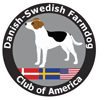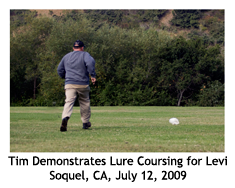Lure Coursing
The Lure of the Lure
Lure Coursing for Sport and Fun
by Tonya Jensen for the DSFCA Web Committee, 2009
Lure
Coursing, what is Lure Coursing? 1.2.3. Lure
Coursing might be described as fantasy, insanity and fun at their
best and all rolled into one, 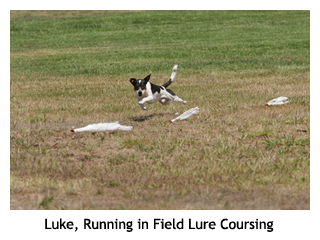 at
least from the view point of dogs. A common plastic bag excites
the dog's natural prey drive to a frenzied level as the dog chases
the lure and his/her instinct kicks into full gear for the kill.
at
least from the view point of dogs. A common plastic bag excites
the dog's natural prey drive to a frenzied level as the dog chases
the lure and his/her instinct kicks into full gear for the kill.
The American Sighthound Field Association describes Lure Coursing this way
"Lure Coursing is a performance event developed in the early 70's by Lyle Gillette and other California sighthound fanciers who hunted jackrabbits in the open field, which risked the harm [to their dog] caused by barbed wire fencing. They invented lure coursing as a safer, more controlled sport for sighthounds that would recreate the physical requirement of open coursing."
 Mere humans will marvel at the intensity of the dogs while they
chase an artificial lure (usually a common plastic grocery bag)
across a field following a pattern that simulates live coursing
of prey. A typical course is between 600 and 1000 yards and requires
roughly five acres to set. In some unofficial events, obstacles
and/or jumps are incorporated. Turns are included in the course
to simulate the movement of fleeing prey such as a rabbit, that
would naturally change direction during a chase. Fields may or
may not be fenced as the dog is normally so lure focused that
they will follow the lure from start to finish and not be likely
to give a second thought to running off course. A dog experienced
at the lure may anticipate or "cheat” by attempting to cut corners
and intercept the lure.
Mere humans will marvel at the intensity of the dogs while they
chase an artificial lure (usually a common plastic grocery bag)
across a field following a pattern that simulates live coursing
of prey. A typical course is between 600 and 1000 yards and requires
roughly five acres to set. In some unofficial events, obstacles
and/or jumps are incorporated. Turns are included in the course
to simulate the movement of fleeing prey such as a rabbit, that
would naturally change direction during a chase. Fields may or
may not be fenced as the dog is normally so lure focused that
they will follow the lure from start to finish and not be likely
to give a second thought to running off course. A dog experienced
at the lure may anticipate or "cheat” by attempting to cut corners
and intercept the lure.
Dogs under one year of age should not participate in Lure Coursing (nor should they compete in dog sports such as agility and flyball); hard fast turns are tough on a dog's developing joints and until the growth plates are closed, the movements required in sports can cause joint problems later in life. If considering a dog sport, a wise owner will have the dog x-rayed to be sure the growth plates are closed before participating in any activity that requires strenuous and unusual movements from the dog. The plate closure in Farmdogs is likely to occur sometime between twelve and eighteen months of age. (X-ray of my Farmdog showed his plates to be closed at fourteen months.) Some sports offer foundation work that focuses on techniques to prepare the dog for the activity of choice without putting stress on the delicate and as yet not completely developed joints of young dogs.
 Lure
coursing requires some expensive equipment. Lures are attached
to a braided fish line (usually 100 pound test trolling line
and mounted around a series of pulleys staked to the ground on
a field measuring approximately five acres. The lure machine
is a device often constructed from a 1955 to 1962 Ford starter
motor mounted in a frame, which features a long drive shaft upon
which is mounted a drive wheel that allows the line to run in
a groove. The lure machine is capable of rapidly changing direction
and speed of the lure.
Lure
coursing requires some expensive equipment. Lures are attached
to a braided fish line (usually 100 pound test trolling line
and mounted around a series of pulleys staked to the ground on
a field measuring approximately five acres. The lure machine
is a device often constructed from a 1955 to 1962 Ford starter
motor mounted in a frame, which features a long drive shaft upon
which is mounted a drive wheel that allows the line to run in
a groove. The lure machine is capable of rapidly changing direction
and speed of the lure. 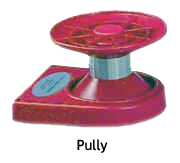 The
starter motor is DC and often uses a power source such as provided
by deep-cycle 12-volt marine batteries, by two or three car batteries
in parallel, or a jumper cable attached to a running vehicle.
The lure machine must be capable of driving the lure at speeds
up to 40mph. Control of the lure is gained by an on/off thumb
switch connected to the low-current side of the starter solenoid.
The lure needs to be configured so that it provides enough speed
to keep the lure in front of the dogs.
The
starter motor is DC and often uses a power source such as provided
by deep-cycle 12-volt marine batteries, by two or three car batteries
in parallel, or a jumper cable attached to a running vehicle.
The lure machine must be capable of driving the lure at speeds
up to 40mph. Control of the lure is gained by an on/off thumb
switch connected to the low-current side of the starter solenoid.
The lure needs to be configured so that it provides enough speed
to keep the lure in front of the dogs.
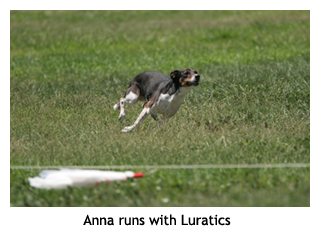 One
company, Luratics http://luratics.com,
was started because it was difficult to find non-breed club sponsored
Lure Coursing that would allow breeds other than sighthounds
to enjoy this natural prey driven thrill of the chase. After
struggling with large, heavy, expensive and tempermental Lure
Coursing systems that were then available, Luratics desigining,
build and offers for sale, their own luring systems, some simple
enough that they could be used in a large backyard and others
that are competition worthy.
One
company, Luratics http://luratics.com,
was started because it was difficult to find non-breed club sponsored
Lure Coursing that would allow breeds other than sighthounds
to enjoy this natural prey driven thrill of the chase. After
struggling with large, heavy, expensive and tempermental Lure
Coursing systems that were then available, Luratics desigining,
build and offers for sale, their own luring systems, some simple
enough that they could be used in a large backyard and others
that are competition worthy.
Lure Coursing under sanction by various dog registries or breed clubs is normally available to sighthounds only. In the United States, events for sighthounds are sanctioned by the American Kennel Club (AKC) and the American Sighthound Field Association (ASFA). In Europe, only four breeds from Group 5 (Cimeco dell'Etna, Pharaoh Hound, Podenco Canario, and Podenco Lbicenco [Ibizan Hound]) are allowed to participate in events sanctioned by FCI and the European Lure Coursing Championships, however, they are limited in the titles they may receive. These sanctioned meets in many cases require that the dogs be muzzled, multiple lures are set on the line and that the often dogs run in groups. However, Lure Coursing for fun is open to any breed and is becoming a popular event. Lure Coursing for fun is found in two styles: 1) Field Lure Coursing on a course without obstacles one dog at a time and without a muzzle, and, 2) Obstacle Lure Coursing which includes turns, jumps, and tunnels in fenced lanes where a single un-muzzled dog must maneuver these obstacles while chasing the lure.
Lure Coursing Fanatics (http://www.lurecoursingfanatics.com) is a group that sponsors Field Lure Coursing for fun - single dog field luring without muzzles.
"Many dogs love the thrill of the chase, not just sighthounds. It doesn't matter if your dog is a Chihuahua or a Great Dane, if they love to chase things they will LOVE Lure Coursing! And even if you think they won't many people are very surprised when their dogs go nuts for the lure!"
Lure Coursing Fanatics, located in Somers, Wisconsin - just north of Kenosha, and accessible from parts of Illinois as well provides recreational Lure Coursing for all breeds. (Driving directions can be found on their Web site at: http://www.lurecoursingfanatics.com/map.htm ) Lure Coursing Fanatics has created these comical titles for dogs that lure for fun with them. These titles give a good insight as to what one might expect from their dog when introduced to the lure.
LURE COURSING FANATIC NOVICE (LCF-N)
Follow: The dog makes an attempt to follow the lure.
Anticipation/Enthusiasm: The dog enters the field easily and shows some interest in the chase.
The Kill: The dog investigates the lure at the end - sniffing and maybe mouthing it.
Lack of Obedience: The dog still listens and obeys commands as normal.
LURE COURSING FANATIC INTERMEDIATE (LCF-I)
Follow: The dog follows the lure completely around the field at least once.
Anticipation/Enthusiasm: The dog enters the field with excitement and eagerly chases the lure.
The Kill: The dog catches the lure at the end - grabs it and then lets go.
Lack of Obedience: The dog's normal level of obedience is affected but they still respond to commands (eventually).
LURE COURSING FANATIC ADVANCED (LCF-A)
Follow: The dog chases the lure around the field as often as we will let them.
Anticipation/Enthusiasm: The dog pulls the owner into the field when it's their turn and must be dragged out when their turn is over.
The Kill: The dog catches the lure at the end - grabs it and then has to be told by their owner to let go.
Lack of Obedience: The dog needs to be given commands multiple times - the chance they will listen is about 50/50.
LURE COURSING FANATIC EXCELLENT (LCF-E)
Follow: While awaiting their turn, the dog tries to follow the lure from outside the field (usually pulling their owner's arm out of it's socket) when another dog is running.
Anticipation/Enthusiasm: The dog rips a hole in their soft sided crate and runs to the gate to the field or the dog yanks it's owner off their feet and drags their prone body to the gate.
The Kill: The dog catches the lure, shakes it and "kills" it (taking the line off the pulleys). The lure needs to be forcibly removed from the dog.
Lack of Obedience: The dog is all but deaf to any commands the owner gives unless they are out of sight and hearing of the lure and the dog currently running
TRUE LURE COURSING FANATIC (TLCF)
Follow: The dog follows the line even when it's not moving and/or follows where the line USED to be after it's been put away!
Anticipation/Enthusiasm: The dog starts whining as soon as their owner turns off the highway and onto our street - still 2 MILES away! If the dog sees a plastic bag in everyday life - they will chase, catch and "kill" it. Your groceries are not safe!
The Kill: The lure needs to be cut from the line because the dog will NOT give it up! (We ask that those with dogs that meet this criteria bring their OWN lures!)
Lack of Obedience: What obedience?!? The owner knows better than to even try!
|
|
Course a' Lure - Obstacle
At http://www.coursealure.com is an organization in Utah that provides Obstacle Lure Coursing for events. Obstacle Lure Coursing was originally developed for terriers but is now enjoyed by all breeds hungry for the chase. See this fun for yourself by enjoying the video below of Obstacle Lure Coursing in action.
Long movie (4 minutes), but you can stop it at anytime. It shows just how any breed can do this sport.
The Human Roll in Lure Coursing According to the Dog
-
Get up --- let's go, if you needed coffee, you should have gotten it ready last night. Mom doesn't need makeup or to blow dry her hair, no one is going to pay any attention to her anyway.
-
Break all speed records getting the dog to the Lure. NOTHING is more important if you ask your dog!
-
Be first in line to register and pay all fees if there are any.
-
Wait patiently while the dog barks endlessly (barking is allowed at the maximum level during Lure Coursing) while being restrained until his/her turn to run. If done correctly, barking should continue at a loud and fevered intensity during the entire event, possibly even starting miles from the event site and continuing as long as the sound of the lure can be heard. FORGET any human conversation during Lure Coursing, you are wasting your time.
-
Put up with the dog pulling arms out of their sockets and plant feet firmly in the ground to resist the dog's intense determination to run every race in anticipation of his/her turn at the lure. (Hope you ate your Wheaties before you set out to Lure Course.)
-
Release the dog to run.
-
Stand ready to retrieve the dog at the end of the chase and if possible pry the lure from the dog's mouth. (HaHa--I want to be there with camera in hand to watch and record this.)
Enjoy the photos and videos of some of our Farmdogs that are definitely FANATICAL to chase the lure!
Farmdogs Lure Coursing
Sometimes it takes a little human intervention...
|
Not all dogs are comfortable with running away from their owners. Some dogs that participate in sports such as Obedience and Agility are trained to watch the handler for signals. They have to be shown that it is okay to chase the lure. Several years ago we had a group of young
Farmdogs training for Flyball. They would run the Obstacle
Lure course until they jumped the four jumps in a row.
At that point they turned around and returned back to
the handler. They too had to be shown that it was okay
to chase the lure the full course. |
 |
|---|---|
References
-
1. Wikipedia, the free encyclopedia, http://en.wikipedia.org/wiki/Lure_coursing
-
What is Lure Coursing? Information taken from "Dog World Magazine," http://gvfrre.org/lurecoursing.htm
-
FAQs from What is Lure Coursing, Bonnie Dalzell, http://www.k9web.com/dog-faqs/activities/lurecoursing.html
Farmdogs that have done Lure Coursing
Anna * |
Dottie |
Nellie * |
|---|---|---|
| * Also have done Obstacle Lure Coursing | ||
